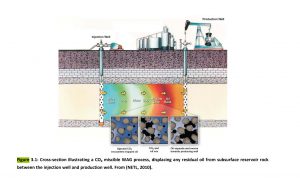Diffusion as an Oil Recovery Mechanism During CO2 Injection in Fractured Reservoirs
Abstract
This thesis is part of an ongoing study of enhanced oil recovery by CO2 injection in the Reservoir Physics research group at the Department of Physics and Technology (IFT) at the University of Bergen. This work investigates the feasibility of oil recovery from diffusion during miscible CO2 injection in fractured core plugs by conducting appropriate laboratory tests and numerical simulations.
A total of 10 miscible CO2 injection tests were conducted in the laboratory using artificially fractured core plugs and were performed in four laboratories: ConocoPhillips Research center in Bartlesville, Oklahoma; Texas A&M in College Station, Texas; Haukeland University Hospital and at IFT. A feasibility study for oil recovery by CO2 injection in unconventional oil shale reservoir was performed. The results show that recovery of oil took place by molecular diffusion from tight shale cores with permeability on the order of nanodarcies. More experiments are needed to draw definite conclusions on this matter.
A novel approach was tested using explicit imaging of CO2 with 11C as nuclear tracer in the CO2 phase. Dynamic displacement was visualized using a PET/CT scanner. Early breakthrough of CO2 was caused by a high injection rate and fingers developed through the high conductive fracture; preventing CO2 from saturating the whole fracture whereas only a small area was saturated with CO2. Still, diffusion of CO2 into the matrix from this area of the fracture was successfully visualized during a small time period limited by the short lifespan of the tracer.
As a part of this thesis, a high pressure CO2 experimental setup was designed and built at IFT. To achieve a diffusion dominated recovery the cores were cut along the cylinder axis and equipped with a high conductive spacer to maintain an open fracture to limit viscous forces in the displacement of oil and thereby isolating the recovery mechanism to molecular diffusion alone. Oil recovery during injection of supercritical CO2 injection (P = 107 bar, T = 42 °C) in a fractured, 100% oil saturated core plug was visualized in a CT-scanner. CO2 concentration profiles were calculated from the development in spatial distributed CO2 saturation during the experiment. The CT images confirmed that molecular diffusion from the fracture to the oil saturated matrix was the dominating recovery mechanism. This was also confirmed by the absence of a differential pressure across the core during CO2 injection. Total recovery reached 96% OOIP after approximately 7 pore volumes of CO2 injected. An effective diffusion coefficient was calculated to be De = 1.66*10-9 ± 7.2*10-10 m2 /s from concentration profiles based on a graphical method of solving Fick’s second law of diffusion. Results from several mass balance injection tests confirmed the large potential with the use of miscible CO2 injection for EOR, with recoveries ranging from 95-98% OOIP, if large enough quantities of CO2 were injected. The final recovery was not affected by the presence of irreducible water saturation but the flood was less efficient as a larger amount of injected CO2 was required to obtain the same end-point saturation.
Numerical simulations have been performed with CMG GEM simulator and matched with the CO2 visualization experiment with oil recovery by diffusion. The simulations satisfactorily reproduced the experimental data and an effective molecular diffusion coefficient of De = 3.02*10-9 m2/s was estimated.
A sensitivity parameter study was conducted with known parameters that influence oil production by diffusion and was focused on changes in porosity, permeability and the diffusion coefficient. The model was not sensitive to variation in permeability ranging from 1 nD to 1D. The CO2 diffusion process was, however, strongly influenced by changes in porosity and the diffusion coefficient. The model also confirmed that oil was only recovered at miscible conditions between the injected CO2 and oil. The validated model should be further developed to study parameters that impact diffusion and can be used to predict oil production in more complex scenarios and possibly on field scale.


